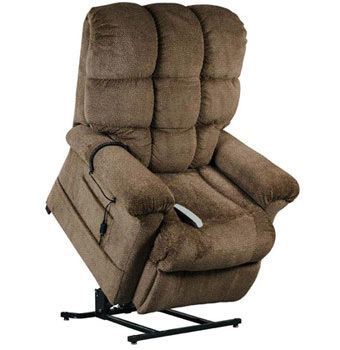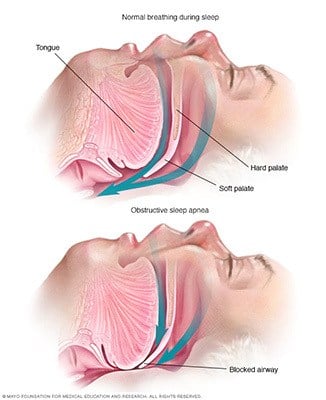TL;DR – How to Sleep in a Recliner
Why do I sleep better in a recliner than in a bed?
Unfortunately, there’s not a simple answer to that question. A lot of it depends on you and why you’re unable to get a decent night’s sleep in a bed.
Many of those reasons have to do with medical issues, which we’ll talk about at various points in this article, so right up front, let us make one thing clear:
This is the Chair Institute. We know chairs, not medicine. We’re not giving medical advice in this or any other article you may read here. We strongly urge you to speak with your doctor if you want medical advice about any topic.
With that out of the way, let’s outline a few of the more common scenarios where people might wind up spending more than a few nights sleeping in their recliners.
Why Some People Sleep in A Recliner?

Whatever your reasons for gravitating toward sleeping in your trusty recliner rather than your bed, this is the article for you. Not only will we outline the best way to get a decent night’s sleep in your recliner, but we’ll also answer a variety of other health-related questions surrounding sleeping in a chair rather than in a bed.
How to Sleep in a Recliner
We’re repeating the steps outlined in our summary here just so you don’t have to scroll back to the top! We’ll also be providing some additional notes and observations.
Sleeping in a Recliner If You Have Sleep Apnea
Does sleeping in a recliner help sleep apnea? Before we can answer that question, we’ll need to take a step back and explain sleep apnea a bit.
What Is Sleep Apnea?
In summary, sleep apnea is a condition in which one’s breathing stops and starts repeatedly during the course of a given night.
Types of Sleep Apnea
There are three major “types” of Sleep Apnea. These are:
You may not know right away that you have sleep apnea because although you’ll come at least partially awake gasping for breath at various points in the night, you may not fully regain consciousness.
You may wake up the next morning feeling like you didn’t get much sleep but are unable to recall why. In that case, a sleep study is the best way to determine what’s going on, but a variety of symptoms point to sleep apnea.
Symptoms of Sleep Apnea
The more of the symptoms above that apply to you, the more likely it is that you have sleep apnea.
In addition to examining symptoms, discussing risk factors is important since several things can increase the likelihood of developing sleep apnea.
Risk Factors
So back to the question: Can sleeping in a recliner help if you have sleep apnea?
The answer is probably. It will help if you have obstructive sleep apnea, and it will help a bit if you have complex sleep apnea because at least part of the problem is caused by the narrowing of your airway when your muscles relax.

By sleeping in a recliner and not laying perfectly flat, the simple force of gravity will work in your favor. When you fall asleep, and your muscles relax, instead of closing off your airway, it will remain open sufficiently so you don’t choke or gasp.
Unfortunately, if you suffer from central sleep apnea, where the problem is the signals your brain is sending to your muscles, then no. In that case, changing where you sleep isn’t going to help fix the problem.
Frequently Asked Questions
-
Is it healthy to sleep in a recliner?
The short answer is “it can be,” but that’s not very satisfying, so here’s a more detailed answer.
According to recent studies, Americans spend too much time sitting in chairs, which is unhealthy and leads to all sorts of health problems, including sore joints, aching backs, weaker hearts, and the like. That’s not the fault of the recliner, though. There’s nothing magical about recliners that makes those conditions worse; it’s more of a lifestyle thing, and recliners are a part of that equation.
It’s also true that not all recliners are created equally, and some are better for your back than others. A handful of recliners on the market today incorporate ergonomic features like lumbar support into their designs, and these are better for you than chairs without those features.
In addition, recliners that offer advanced seating positions, like Zero-G and Trendelenburg, have well-documented positive health benefits.
Recent studies have shown that if you’ve recently recovered from surgery, you’ll recover more quickly if you spend your recovery in a highly adjustable recliner. In addition to that, sleeping in a recliner has been found to relieve the symptoms of a variety of conditions including, but not limited to:
– GERD (Gastroesophageal Reflux Disease)
– Acid Reflux
– Heartburn
– Sleep Apnea
– And SnoringWhile sleeping in a recliner won’t, by itself, make you healthier, if you’ve recently had surgery or suffer from any of the above, you’ll almost always notice an improvement.
-
Is it safe to sleep in a recliner while pregnant?
According to WebMD, it’s perfectly acceptable to sleep in a recliner while pregnant, and in fact, a significant minority of women give up entirely on the idea of sleeping in their bed at night, preferring the convenience of sleeping in their recliner, often with a pillow between their legs or with a body-length pillow for added comfort.
-
Is sleeping in a recliner bad for you and your back?
Sleeping in a recliner isn’t especially good or bad for lower back pain, but recent studies have shown that too much time spent sitting can be detrimental to your health and can make back pain worse.
For that reason, it’s well worth the time and extra money to buy good-quality furniture with ergonomic features built-in. There aren’t a huge number of recliners on the market today that offer ergonomic features, but there are some, and even better, they’re offered by well-respected American furniture brands.
The Anatomy of a Good Sleeper Recliner
We mentioned earlier that not all recliners are created equal. Some are optimized for lounging, while others are geared much more toward sleeping. The specific features on offer make all the difference here, and if you’re looking for a recliner to sleep in, here are the features that will make the biggest impact:
Upholstery

We mentioned this earlier. There’s a reason you don’t have leather sheets on your bed. Leather is a horrible material to sleep on. It’s not at all breathable, and you’ll wake up the next morning covered in sweat, assuming you can make it through the night in the chair.
If you already own a leather recliner, your only real option is to lay a top sheet down over the leather, which gives you a layer of fabric against your skin, but if you haven’t bought one yet, save yourself the extra step and just buy a fabric-clad recliner to start with. It will be much more breathable, which will translate into a better and more comfortable night’s sleep.
An Advanced Comfort System
Different companies handle comfort in different ways, but at a minimum, you should look for a recliner that utilizes block foam and poly fiberfill paired with comfort coils or some type of spring-supported system that closely mimics the feeling of resting on a mattress.
However, some companies go far beyond this, offering memory foam, gel-infused comfort coils, and the like. Personal tastes and preferences will vary, of course, so if possible, visit a furniture showroom near you and try as many models out as you can to get a sense of what type of comfort system you prefer.

The More Recline Positions, the Better
Power recliners generally make better sleepers than manual ones, simply because they offer an infinite number of possible recline angles, allowing you to find your comfort sweet spot.
Manual recliners typically only offer three recline positions, and if those don’t work for you, you’re left having to tweak your angle with the creative use of pillows. It can work, but it’s far from optimal.
Advanced Features & “Extras”

This is a mixed bag, and not every company offers extras, but you should keep an eye out for them. Here, we’re talking about recliners that offer lumbar or whole-back ergonomic support, power recliners with battery backup systems (which are disappointingly rare), and the like. We’ve even found a handful of recliners with an independently adjusting headrest, which is amazing!
Advanced features also include advanced seating positions like Zero-G and Trendelenburg. We’ve never seen a chair that offers both.
It’s usually one or the other. That’s fine, though, because they offer comparable benefits. Having both in the same model would, in our view, be over-engineering the chair in question.
One thing you’ll notice that’s conspicuously absent from our list is the ability to lay completely flat. Some people may want that, while others won’t. If you have sleep apnea or are recovering from recent surgery, the odds are that you don’t want to lay flat anyway, so this ultimately comes down to what your needs are. It’s just not a universal requirement.
Final Thoughts – How to Sleep In A Recliner
So, is it ok to sleep in a recliner? Ultimately, the answer is yes, but the question itself is mostly self-selecting.
If given a choice, most people would probably rather sleep in their bed. Under certain conditions, though, that simply becomes impractical, if not outright impossible. In those instances, the right sleeper recliner is an excellent alternative.
If you find yourself in need of one, take the time to make sure the one you purchase fits you well, and at a minimum:
If you do that, you’ll virtually guarantee yourself a great night’s sleep in your recliner.
References & Resources:
- Sleep Soundly During Pregnancy, WebMD.
- Is it Dangerous to Sleep Sitting Up?, Harvard Health.
- 5 Health Benefits of Sleeping in Your Recliner, Furniture Academy.
- Sitting in Reclined Position May Help Alleviate Back Pain, News Medical.
- Effects of Recliner-Chair Versus Traditional Hospital Bed on Postsurgical Diagnostic Laparoscopic Recovery Time, NCBI.
